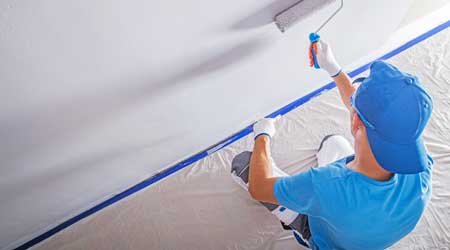 Managers who understand the importance of ensuring that workers perform effective surface preparation are more likely to produce applications that deliver long-term performance.
Managers who understand the importance of ensuring that workers perform effective surface preparation are more likely to produce applications that deliver long-term performance.Paints: The Bottom Line on Surface Preparation
Manufacturers offer insights on effective surface preparation and selecting paints to meet surface needs
Institutional and commercial facilities feature a vast array of interior and exterior surfaces that require paints and coatings to maximize their protection and appearance. From drywall and wood to concrete and metal, these substrates present maintenance managers and front-line workers with challenges related to preparing and protecting them effectively.
Managers who understand the importance of ensuring that workers perform effective surface preparation are more likely to produce successful applications that deliver long-term performance.
Understanding challenges
In performing surface preparation, workers must remove materials that can impair the ability of paints and coatings to properly adhere to the surface. These materials can include old coatings, contaminants, residue, and organic or biological growth. Despite the importance of surface preparation, workers with heavy workloads and small work windows can overlook the process. Unfortunately, applications that take place with little or no surface preparation are likely to require more attention sooner rather than later.
“A coating’s performance is directly affected by surface preparation,” says Rick Watson with Sherwin-Williams. “Coating integrity and service life can be reduced because of improperly prepared surfaces. In fact, about 80 percent of coating failures happen because of improper preparation. If a coating is sticking to a surface contaminant and not to the substrate, it will simply blister and peel. Before any paint goes on the wall, ceiling or trim, and even before areas are taped off, it’s crucial to ensure the area to be painted is clean, dry, dull and sound.”
The price of poor surface preparation can be high.
“This is one of the most important steps in a successful coating application, as it’s estimated that 60-80 percent of premature coating failures are due to either completely or partially inadequate surface preparation,” says Al Morris with Prosoco. “The primary role of proper surface prep is to create the proper profile for the coating, to increase adhesion and to ensure desired performance of the coating.”
The challenges of effective surface preparation are not limited to finding the time to do the work. Workers also must be aware of the areas in which the work has to take place.
“I find that the bigger challenge in facilities isn’t necessarily the surface but when working in occupied spaces or facilities that are in need of a quick return to service, what actual type of surface preparation can be done,” says Mike Mundwiller with Benjamin Moore. “One example is removal of rust. It will take more time to use hand or power tools to remove, but in many facilities it would be impossible to operate an abrasive blasting unit.”
Beyond these issues, the nature of surfaces can complicate the process.
“For substrates such as concrete floors, it is best to build the coating system starting from inside the slab,” Mundwiller says. “That is why surface preparation for concrete floors start with opening the floor up — mechanically or chemically— so the primer penetrates into the slab.”
Material challenges are not limited to concrete.
“Stainless steel and very porous and textured surfaces like stucco present the most surface preparation challenges,” Watson says. “Stainless steel by nature wasn’t meant to be coated, and textured and porous masonry surfaces pose a challenge due to all the nooks and crannies in which dirt, grease and grime can hide. As a result, cleaning and preparing these surfaces takes more time and precision.”
Related Topics:














